I know that almost every gardening book published after 1900 is worthless. I also know that titles written by Arthur Mee, J.B.Priestly, Mazo de la Roche, Hugh Walpole, Frances Parkinson Keyes and Alec Waugh are two a penny.
But even after I've removed all of the middlebrow 1930s novels, book club editions, reprints of the Pilgrim's Progess, sets of encyclopaedias and Reader's Digest publications, I'm still left with thousands of books. To confuse things further, I often find things that aren't books.
Yesterday I found a superb 1928 catalogue from a department store specialising in gentlemen's clothes. I'd never heard of Welch, Margetson & Co, but apparently they were one of the leading companies of their kind, with eight banches in Great Britain, six in Australia and one each in Ireland, New Zealand and Canada, plus agents in every continent.
The London branch had four floors, with whole departments for items like sock suspenders and umbrella handles. Here is a small selection of their wares:
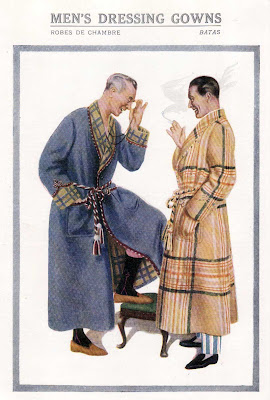 Before they became associated with old age and hospices, these dressing gowns were the height of sophistication.
Before they became associated with old age and hospices, these dressing gowns were the height of sophistication.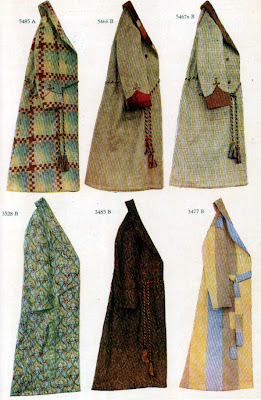 I'm quite fond of the yellow one, whilst my son prefers the Tom Bakeresque one in the upper middle.
I'm quite fond of the yellow one, whilst my son prefers the Tom Bakeresque one in the upper middle.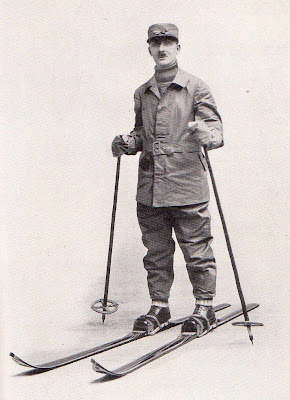 Try to ignore the 'Hitler on Ice' associations. After the bushy moustaches of the Edwardian era, these 'taches were the epitome of style. Hitler's popularity in post-Weimar Germany had nothing to do with his policies. People just loved his cool moustache.
Try to ignore the 'Hitler on Ice' associations. After the bushy moustaches of the Edwardian era, these 'taches were the epitome of style. Hitler's popularity in post-Weimar Germany had nothing to do with his policies. People just loved his cool moustache.The Hitler moustache's popularity obviously waned somewhat after the Second World War (as did the name Adolf) and only the ghastly egotists General de Gaulle and Franco continued to wear them.
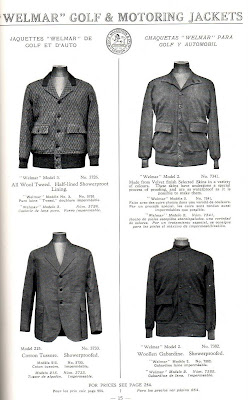 What superb jackets! Stylish, well-cut and clearly good quality. I would pay good money to own any of them.
What superb jackets! Stylish, well-cut and clearly good quality. I would pay good money to own any of them.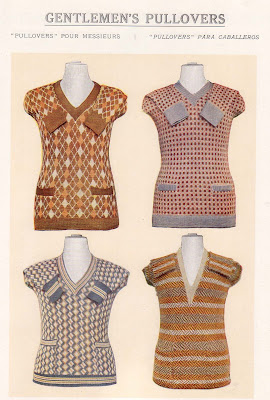 It's strange how contemporary these designs look; to me, at least. I wasn't expecting to find such high quality colour illustrations in a catalogue from 81 years ago. I suppose that Welch, Margetson & Co could afford it, as their clientelle weren't hard up.
It's strange how contemporary these designs look; to me, at least. I wasn't expecting to find such high quality colour illustrations in a catalogue from 81 years ago. I suppose that Welch, Margetson & Co could afford it, as their clientelle weren't hard up.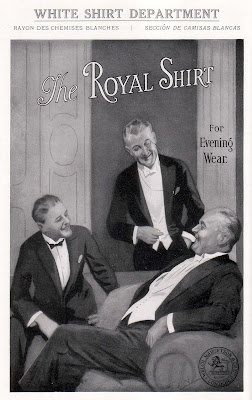 I want to be one of these men, exchanging jovial banter over a postprandial glass of port whilst my chaufferer sits outside, rubbing his hands to keep warm. Actually, in reality I wouldn't be able to enjoy myself knowing that some poor bugger was freezing to death on my account. It's a flaw in my pretensions to be a gentleman.
I want to be one of these men, exchanging jovial banter over a postprandial glass of port whilst my chaufferer sits outside, rubbing his hands to keep warm. Actually, in reality I wouldn't be able to enjoy myself knowing that some poor bugger was freezing to death on my account. It's a flaw in my pretensions to be a gentleman. Ah, the sheer decadence of having to deliberate over the design and colour of a pair of slippers. How grim our sweatshop-made, utilitarian clothes look by comparison.
Ah, the sheer decadence of having to deliberate over the design and colour of a pair of slippers. How grim our sweatshop-made, utilitarian clothes look by comparison.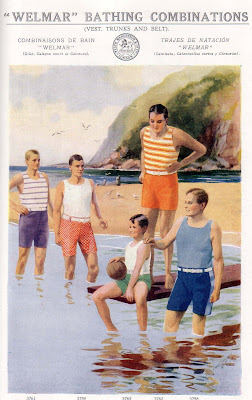 The bathing suit is a pleasing alternative to the pot-bellied, tattooed, nipple-pierced British tourist in the Costa del Sol (and if a certain friend of mine is reading this - no, this isn't an oblique reference to you).
The bathing suit is a pleasing alternative to the pot-bellied, tattooed, nipple-pierced British tourist in the Costa del Sol (and if a certain friend of mine is reading this - no, this isn't an oblique reference to you).I hope it goes without saying that I haven't forgotten the other side of the 1920s and 30s, as chronicled by Orwell and Steinbeck. Indeed, my family probably never set foot in Welch, Margetson & Co and if they had, I expect that they would have been ushered out.
My grandfather was an unskilled labourer in the 1920s. He joined the army in the First World War before he'd had a chance to learn a trade and spent the rest of his life living on the breadline.
One day he got a maintenance job with London Transport and had a slightly Chaplinesque accident with a ladder whilst walking through a tunnel. He fell on the electric line and suffered serious burns, but in those days the concept of sick leave was regarded as some mad, Bolshevik plot. He ended up having to take his two weeks' annual leave at Clacton-on-Sea, where his family relaxed on the beach whilst he was treated at the local burns unit.
As I have said before, the recent past was a great time if you were rich, white, male and abled-bodied, but it could be fairly unforgiving to anyone who wasn't.
The likes of Welch, Margetson & Co were for a certain type of person:
 I don't know exactly when they disappeared, but it looks as if a combination of Michael Caine, nylon and sweatshops were the cause of their demise. I wonder what my grandfather would have made of it all?
I don't know exactly when they disappeared, but it looks as if a combination of Michael Caine, nylon and sweatshops were the cause of their demise. I wonder what my grandfather would have made of it all?

8 comments:
So what did you do with the catalogue? Surely it must have some value ...
Mazo de la Roche - that name brings back memories of a long shelf of pink dust-jacketed novels that rarely seemed to move in the library I worked in as for my Saturday job in the late 1970s.
Another wonderful post. As for the often rather groovy clothes you've shown, you can't help suspecting a lot of them, if looked after, would still be in good shape today, as opposed to the shitty mass-produced stuff I'm currently wearing (says he who split open a pair of pants at work last week while trying to knee a door handle hard enough to open the door, instead of just putting down the boxes I was holding and doing it properly--I also found that electrical tape does not hold denim together very well).
I had a set of Arthur Mee's Children's Encyclopedias as my constant companion to help to while away the tedious hours of a childhood with only two TV channels (and really one of those was verboten). I had no idea he wrote anything else. Luckily. Thank God for The Bobbesy Twins. They knew how to live.
Annabel, I will sell it. I'm just briefly savouring its luxurious wares.
James, ripped jeans are back in fashion (but not around the genital area, yet).
Lucille, I was intereted to read this, from Wikipaedia:
Arthur Mee 'was born on July 21, 1875, at Stapleford near Nottingham, England, to a modest family. As a boy he earned money from reading the reports of Parliament to a local blind man. He left school at 14 to join a local newspaper, where he became an editor by age 20. He contributed many non-fiction articles to magazines and joined the staff of The Daily Mail in 1898. He was made literary editor five years later.
After publishing several books, in 1908 he began work on The Children's Encyclopaedia, which came out as a fortnightly magazine. The series was published and bound in eight volumes soon afterwards, and later expanded to ten volumes. After the success of the Encyclopædia, he started the Self-Educator, and then the first newspaper published for children, the weekly The Children's Newspaper, which was published until 1965.
Although he made money from these works, he did not receive a fair share.[1] He had a large house built overlooking the hills near Eynsford in Kent. Its development from design to the final building was depicted in later editions of The Children's Encyclopedia.
Mee had one child, but, despite his work, declared that he had no particular affinity with children. His works for them suggest that his interest was in trying to encourage the raising of a generation of patriotic and moral citizens. He came from a Baptist upbringing, and supported the temperance movement.'
Thank you for this. Yes I had the full ten volumes in a dedicated book trough. I look forward to seeing what hatches from your giant chrysalis. Could it be a Swallowtail butterfly perhaps? Did you see my Jersey Tiger Moth? (Quite proud of it).
I love the stripey slippers!
I'd treat my chauffer to some rather good gloves and a bodywarmer personally.
You are right that life probably wasn't all that unless you happened to be of lucky birth like the gentlemen portrayed.
The demise of a department store is always so sad though. Even watching 'Are You Being Served?' is unbearably sad in that it's about the obvious slow death of a once-thriving Edwardian department store who does not have the first clue how to move with the times and scares scores more customers away than it attracts.
Unremunerative though Keyes and de la Roche may be, they still have readers. They escape our fiction weeding at the library year after year. Keyes I can understand, as we are in the same Deep South here. I'm surprised that you find so many of her books in the UK. But how does de la Roche's Jalna series survive?
I own a copy of Alec Waugh's "Hot Countries". It has fine woodcuts by Lynd Ward. Until I checked Wikipedia, I had no idea of his enormous output. Wikipedia tags him as a lesser Maugham, but I actually like him better than his insufferably snooty brother.
Evelyn Waugh may have been insufferable and occasionally cruel (the famous banana story doesn't show him in a good light), but 'A Handful of Dust' is one of the most compassionate and humane novels I've ever read.
Post a Comment